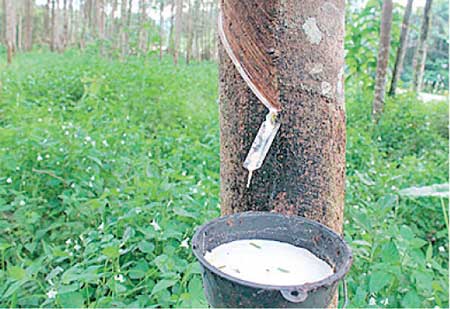Thursday Apr 24, 2025
Thursday Apr 24, 2025
Wednesday, 6 April 2016 01:03 - - {{hitsCtrl.values.hits}}
By Uditha Jayasinghe
Amidst an oil glut and severe weather, the Government is hoping a global floor price for rubber exports under discussion by the world rubber producing countries would give the industry a much-needed reprieve.
The possibility of a floor price, which has been under discussion by the handful of East Asian natural rubber producing countries, will be under discussion yet again at an international summit to be held in Colombo in June, according to Rubber Development Department Director General R.B. Premadasa. 
Local rubber exports dipped 14.5% in 2015 from $889.8 million in 2014 to $761.2 million last year. In December 2015 prices decreased 19.8%, according to the Central Bank. Fresh numbers for 2016 are yet to be released by them.
“We expect the discussions to conclude within the next two to three months. Under a floor price all countries will not export rubber at less than $ 2 per kilo,” he said. Premadasa is confident prices of local sales will see a boost as natural rubber is needed to produce synthetic equivalents, which have become cheaper since the reduction of global oil prices.
However, Colombo Rubber Traders Association Chairman M.S. Rahim, pointed out that the most significant problem in the local industry was the diminishing supply from rubber smallholders, who make up the largest component.
“As estimated 52% of the trees in Sri Lanka are more than 31 years of age. Production has dropped from 150,000 metric tons to 88,000 metric tons as a result,” Rahim told the Daily FT. He insisted that replanting of rubber by the small holders would not be done without a subsidy from the Government but stressed it would be economically unfeasible to rely on hand-outs.
“A floor price, even if it comes into effect, will have limited impact. The Government earlier announced a purchase price for rubber and most smallholders are waiting for it to be implemented resulting in less rubber reaching the auction,” he noted.
In October 2014 Thai and Malaysian rubber producers threw their support behind an Indonesian proposal to set a $1.50 per kg minimum on prices as the world’s top growers attempt to keep their market from being pulled lower by a deepening glut.
But rubber futures in Tokyo and Singapore have slumped to the lowest levels since 2009, suggesting the producers may need to take more drastic measures.
Previous efforts to shore up prices by the three Southeast Asian producers – who account for more than 70% of global natural rubber output – have had little success in the face of abundant supply and weaker demand from top consumer China.
Nonetheless, rubber groups in both Malaysia and Thailand have said they will support a plan by the Indonesian Rubber Association (GAPKINDO) seeking to get producers and exporters to agree not to sell rubber below $1.50/kg.
Indonesia, Thailand and Malaysia, which are grouped under the International Rubber Consortium, last acted jointly in 2012-2013, agreeing to cut exports by 300,000 tons, or about 3% of 2012 global output.
Rubber prices rose temporarily in response to the earlier plan before sliding again due to fears that the debt crisis in Europe could derail demand.
Indonesia, the world’s No. 2 producer, then publicly called for the pact to be discontinued, saying it was not the best solution under the circumstances.
Discover Kapruka, the leading online shopping platform in Sri Lanka, where you can conveniently send Gifts and Flowers to your loved ones for any event including Valentine ’s Day. Explore a wide range of popular Shopping Categories on Kapruka, including Toys, Groceries, Electronics, Birthday Cakes, Fruits, Chocolates, Flower Bouquets, Clothing, Watches, Lingerie, Gift Sets and Jewellery. Also if you’re interested in selling with Kapruka, Partner Central by Kapruka is the best solution to start with. Moreover, through Kapruka Global Shop, you can also enjoy the convenience of purchasing products from renowned platforms like Amazon and eBay and have them delivered to Sri Lanka.
Discover Kapruka, the leading online shopping platform in Sri Lanka, where you can conveniently send Gifts and Flowers to your loved ones for any event including Valentine ’s Day. Explore a wide range of popular Shopping Categories on Kapruka, including Toys, Groceries, Electronics, Birthday Cakes, Fruits, Chocolates, Flower Bouquets, Clothing, Watches, Lingerie, Gift Sets and Jewellery. Also if you’re interested in selling with Kapruka, Partner Central by Kapruka is the best solution to start with. Moreover, through Kapruka Global Shop, you can also enjoy the convenience of purchasing products from renowned platforms like Amazon and eBay and have them delivered to Sri Lanka.